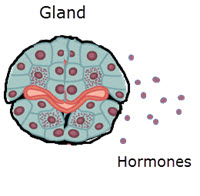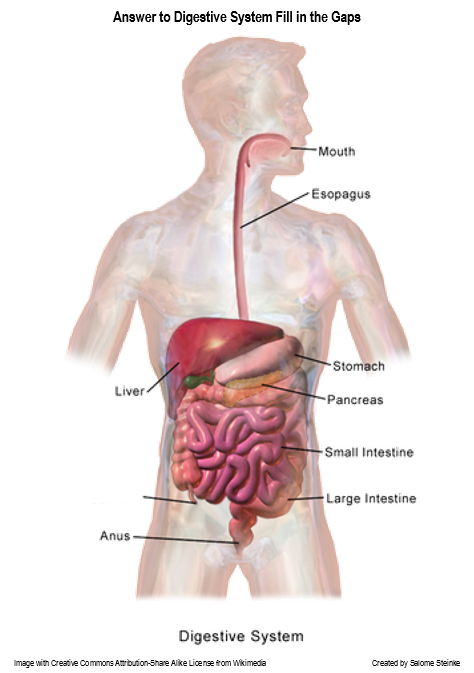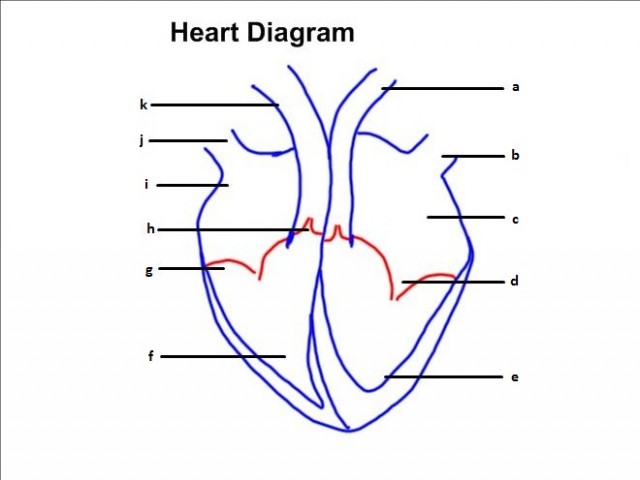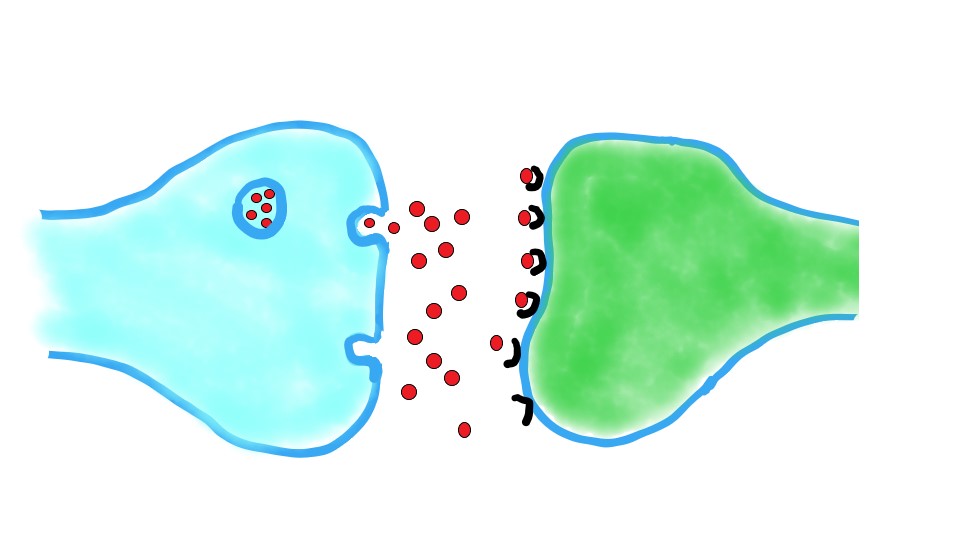Topic 6: Human physiology
This is an introduction to the human physiology topic. It lists understandings and skills expected for Topic 6 including digestion, heart and circulation, immune system, lungs and gas exchange, the nervous system, hormones and reproduction. Helpful for revision.
Detailed revision notes, activities and questions can be found on each of the sub-topic pages:
- 6.1 Digestion & absorption
- 6.2 Blood system
- 6.3 Defence against infectious disease
- 6.4 Gas exchange
- 6.5 Neurons and synapses
- 6.6 Hormones, homeostasis and reproduction
6.1 Digestion and absorption
- The outline structure of the digestive system. (skill - annotated diagram)
- Food is mixed with enzymes and moved along by the contraction of circular and longitudinal muscle of the small intestine.
- Enzymes (amylase, lipase and an endopeptidase) are secreted by the pancreas into the small intestine where they digest macromolecules ( starch, glycogen, lipids and nucleic acids) in food into monomers.
- Tissue layers in the intestines include longitudinal and circular muscles, mucosa and epithelium.
- The presence of Villi in the small intestines increases the surface area of epithelium and helps absorb the monomers formed by digestion and mineral ions and vitamins.
- Different nutrients are absorbed into epithelial cells by different membrane transport mechanisms.
Guidance:
- The enzyme name trypsin and the method used to activate it are not required.
- Students should know that cellulose remains undigested.
Skills (can you ....)
- Apply knowledge of the process or digestion and absorption in the small intestine to the digestion of starch and the transport of maltose and glucose to the liver.
- Describe your experience of the use of dialysis tubing as a model of the intestines.
- Draw an annotated diagram of the digestive system.
- Identify tissue layers in transverse sections of the small intestine
 6.2 Blood system
6.2 Blood system
- Arteries carry blood at high pressure from the ventricles of the heart to the tissues of the body.
- Arteries have muscle cells and elastic fibres in their walls.which maintain blood pressure between ventricle contractions.
- Capillaries carry blood through tissues and have permeable walls to allow exchange between tissue cells and the blood.
- Veins carry blood at low pressure from the tissues to the atria of the heart.
- Valves in veins and the heart prevent back-flow.
- There is a separate circulation for the lungs.
- The sinoatrial node initiates heart beat
- The SA node is made of specialized muscle cells in the right atrium which act as a pacemaker.
- The sinoatrial node sends out an electrical signal which is propagated through the walls of the atria and ventricles.
- The heart rate is controlled by impulses brought to the heart through two nerves from the medulla of the brain.
- Epinephrine (adrenalin) increases the heart rate.
Skills (can you ....)
- Outline your knowledge of William Harvey’s discovery of the circulation of the blood with the heart acting as the pump.
- Interpret pressure changes in the left atrium, left ventricle and aorta during the cardiac cycle.
- Link causes and consequences of occlusion of the coronary arteries.
- Identify arteries, capillaries or veins from the structure of their walls.
- Recognise the four chambers and valves of the heart and the blood vessels connected to it in a dissected heart or in diagrams of heart structure.
6.3 Defence against disease
- The primary defence against pathogens are the skin and mucous membranes.
- Blood clotting seals cuts in the skin. (skin diagrams are not required.)
- Platelets release clotting factors.
- Fibrinogen is converted to fibrin by thrombin.
- Pathogens are ingested by phagocyte cells which gives non-specific immunity.
- Specific immunity is given by production of antibodies by lymphocytes in response to particular (antigens on) pathogens
- Antibiotics block prokaryotic cell processes but not processes in eukaryotic cells.
- Viruses lack a metabolism and cannot be treated with antibiotics.
- Some strains of bacteria have evolved antibiotic resistance and even multiple resistance.
- The effects of HIV on the immune system should be limited to a reduction in the number of active lymphocytes and a loss of the ability to produce antibodies, leading to the development of AIDS
- Subgroups of phagocyte and lymphocyte are not required but students should be aware that some lymphocytes act as memory cells and can quickly reproduce to form a clone of plasma cells if a pathogen carrying a specific antigen is re-encountered.
Skills (can you ....)
- Outline causes and consequences of blood clot formation in coronary arteries.
- Describe Florey and Chain’s experiments to test penicillin on bacterial infections in mice.
- Describe the effects of HIV on the immune system and methods of transmission.
6.4 Gas Exchange
- Concentration gradients of oxygen and carbon dioxide between air in alveoli and blood flowing in adjacent capillaries are maintained by ventilation.
- Draw a diagram to show the structure of an alveolus and an adjacent capillary. Alveoli consist of two types of pneumocytes;
- Type I are extremely thin and are adapted to carry out gas exchange.
- Type II secrete a solution containing surfactant that creates a moist surface inside the alveoli. This reduces surface tension and prevents the sides of the alveolus sticking to each other.
- The trachea and bronchi carry air to the alveoli in bronchioles in the lungs.
- Muscle contractions cause the pressure changes inside the thorax that force air in and out of the lungs to ventilate them.
- External and internal intercostal muscles, and diaphragm and abdominal muscles are antagonistic muscles, required for inspiration and expiration because muscles only work by contracting.
Skills (can you ....)
- Link causes and consequences of lung cancer.& emphysema to structure of lungs.
- Monitor ventilation in humans at rest and after mild and vigorous exercise. (Practical 6)
- Ventilation rate and tidal volume should be measured, either be monitored by simple observation and simple apparatus or
- by data logging with a spirometer or chest belt and pressure meter. (residual vol, & vital capacity not required)
 6.5 Neurones and synapses
6.5 Neurones and synapses
- Electrical impulses are transmitted in Neurons. (details of neuron types not required)
- Sodium and potassium ions are pumped across neuron membranes to generate a resting potential.
- Action potentials are depolarization and repolarization of the neuron which are propagated along the axons of neurons creating nerve impulses. (oscilloscope traces showing resting potential & action potential.)
- Local currents cause each successive part of the axon to reach the threshold potential.
- Myelin sheath cells around the axons of nerve fibres allows for saltatory conduction.
- Synapses (only chemical synapses) join neurons and also join neurons to receptor or effector cells.
- Depolarized pre-synaptic neurons release a neurotransmitter into the synapse.
- A nerve impulse is only initiated if the threshold potential is reached.
Skills (can you ....)
- Understand that secretion and reabsorption of acetylcholine by neurons occurs at synapses.
- Illustrate how blocking of synaptic transmission at cholinergic synapses in insects by the binding of neonicotinoid pesticides to acetylcholine receptors can work as a pesticide.
- Outline how the workings of neurotransmitters and synapses has led to the development of numerous pharmaceuticals for the treatment of mental disorders.
6.6 Hormones and reproduction
- Hormones travel in the blood more slowly than nerve impulses but are more widely distributed
- Insulin and glucagon control blood glucose (cells in islets of pancreas)
- Thyroxin regulates metabolic rate & partly controls body temperature. (thyroid gland)
- Leptin acts on the hypothalamus of the brain to inhibit appetite (secreted by cells in adipose tissue)
- Melatonin controls circadian rhythms (jet lag) (secreted by pineal gland.)
-
Hormones in human development & reproduction
- The sry gene of the Y chromosomes causes embryonic gonads to develop as testes and then they secrete testosterone which causes pre-natal development of male genitalia. In puberty it causes, development of male secondary sexual characteristics and sperm production.
- Estrogen and progesterone cause pre-natal development of female reproductive organs and in puberty the female secondary sexual characteristics.
- In the menstrual cycle FSH, LH, estrogen and progesterone have roles in negative and positive feedback mechanisms.
- IVF uses drugs to suspend the normal secretion of hormones, followed by the use of artificial doses of hormones to induce superovulation and establish a pregnancy.
Skills (can you ....)
- Understand the causes and treatment of Type I and Type II diabetes.
- Outline how tests using leptin on obese patients didn't reduce their obesity and give reasons why.
- Understand how melatonin can be used to help alleviate jet lag.
- Homeostasis of glucose
- Annotate diagrams of the male and female reproductive systems with the names & function of structures.
- State that scientific discoveries often follow developments in equipment, and illustrate this with the example that microscopes were not available for William Harvey’s investigation of sexual reproduction in deer so he failed to solve the mystery of sexual reproduction

Blood system 6.2
Revise and learn how to sketch the diagram of a heart, label heart chambers and blood vessels, distinguish between arteries, veins and capillaries, describe the cardiac cycle, the control of the heart rate and the causes and consequences of occlusion.

Defence against disease 6.3
This topic covers the production of antibodies and the cascade of reactions in blood clotting. The functions of blood cells in the immune system as well as specific immunity and antibodies. Methods of transmission of HIV is also included.

Digestion & absorption 6.1
The human digestive system, its parts and functions are in this topic. This includes digestive enzymes, their optimum conditions, substrates and products, as well as detailed structure of villi and microvilli.

Gas exchange 6.4
Learn about the difference between the ventilation system and gaseous exchange. This topic covers the functions of parts of the lung, the mechanism of inspiration, expiration and the structure of the alveolus.

Hormones and reproduction 6.6
Learn about homeostasis, thermoregulation, control of blood glucose, diabetes, leptin, melatonin, male and female reproductive systems, the SRY gene, secondary sexual characteristics and the menstrual cycle.

Neurones and synapses 6.5
This topic covers neurons and synapses. Get to grips with the structure of a neuron, the propagation of action potentials along a neuron and the transmission of electrical impulses across a synapse. There is also a specific look at cholinergic synapses.

 Twitter
Twitter  Facebook
Facebook  LinkedIn
LinkedIn